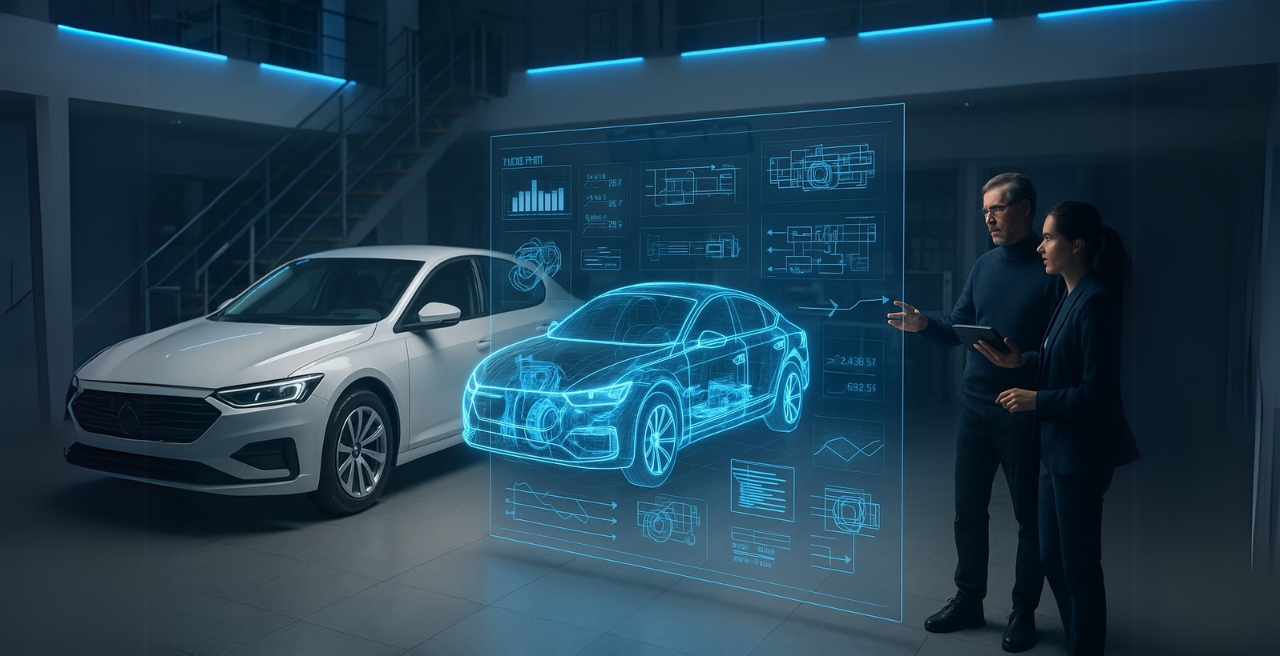Introduction
Technology is changing the way companies design and build products. One of the most exciting changes is digital twin technology. A digital twin is a virtual version of a real product. It shows how the product looks, how it works, and how it will perform in the real world. When digital twin technology is used with Product Lifecycle Management (PLM) systems, it can help businesses work faster, reduce costs, and make better products. In this blog, we will explain how digital twins and PLM are changing product development.
What is Digital Twin Technology?
A digital twin is a digital copy of a physical object. This copy is connected to the real object using data from sensors, machines, and software. For example, if you make a car, the digital twin will show how that car will act in different situations—before you even build it.
Digital twins are used in many areas, such as:
- Manufacturing
- Healthcare
- Construction
- Automotive
- Aerospace
They help companies understand their products better, test ideas without building real models, and catch problems early.
What is Product Lifecycle Management (PLM)?
PLM stands for Product Lifecycle Management. It is a system that helps manage a product from the beginning (idea) to the end (retirement). PLM includes all the information, files, and people involved in product development.
PLM helps in:
- Managing product data
- Controlling versions of files and models
- Keeping track of changes
- Working with teams across departments
- Staying organized and meeting deadlines
When PLM works with digital twins, companies get a full view of their products—in both the digital and physical worlds.
How PLM and Digital Twins Work Together
PLM and digital twins make a strong team. Here’s how they help each other:
Data Sharing
PLM stores all the information about the product—designs, tests, materials, and changes. This information feeds the digital twin. The twin can then use real-time data to show how the product is working.
Real-Time Monitoring
If sensors are added to a real product, the digital twin can receive live data. PLM makes sure that this data is connected to the right version of the product model. This helps teams monitor the product while it’s being used and fix issues quickly.
Better Testing
With digital twins, companies can test products in the digital world. They can see how the product performs under heat, pressure, or movement. PLM makes it easier to manage all the test results and link them to product changes.
Faster Changes
If a problem is found in the digital twin, the PLM system helps teams make changes quickly. They can update the design, check the results, and send it for manufacturing—all in one place.
Benefits for Product Development
1. Improved Design Quality
Design teams can use digital twins to test new ideas before building anything. They can find design issues early, saving time and money.
2. Faster Time to Market
With digital testing and better data management, companies can move from idea to finished product much faster.
3. Lower Costs
Making physical prototypes is expensive. Digital twins let companies run tests without needing to build many versions. This saves material and labor costs.
4. More Innovation
Because teams can try out ideas in a digital space, they are more likely to test bold and creative designs.
5. Real-World Feedback
Once the product is being used, the digital twin collects data from sensors. This shows how the product performs in real life. Companies can use this data to improve the next version of the product.
Industries Using Digital Twin and PLM
Many industries are already using these technologies to improve product development:
- Automotive: To design safe and efficient vehicles
- Aerospace: To test aircraft performance without flying
- Manufacturing: To monitor machines and predict problems
- Energy: To check power systems and avoid breakdowns
- Healthcare: To test new devices and equipment
These industries use digital twins and PLM to reduce risks and increase success.
Challenges to Keep in Mind
While digital twin and PLM systems offer many benefits, they also come with a few challenges:
- High cost at the start: These systems need software, training, and good planning.
- Data security: As data moves between systems, keeping it safe is very important.
- Learning curve: Teams may need time to get used to the new way of working.
Still, the long-term benefits often make the investment worthwhile.
The Future of Digital Twins and PLM
As more companies use Internet of Things (IoT) devices, digital twins will become even more powerful. They will give even better real-time data. Artificial intelligence (AI) will also play a big role by helping teams make smarter decisions using the data from digital twins.
PLM systems will continue to grow and connect with more tools. This will help companies manage every part of the product lifecycle in one place.
In the future, businesses will be able to:
- Create smart, connected products
- Predict problems before they happen
- Offer better services to their customers
Conclusion
Digital twin technology, when combined with PLM, is changing the way products are developed. It helps companies design, test, and improve products faster and with fewer mistakes. From cars to machines to medical devices, digital twins are helping teams create better, safer, and more efficient products.
If your company wants to stay competitive and build better products, learning how to use digital twin technology and PLM together is a smart move. It’s not just the future—it’s already here.

















